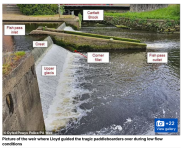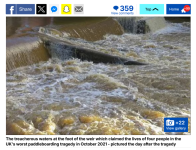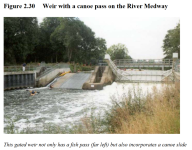BTW, that "fish ramp" is a sluice for paddlers, common in Europe.
I find that very difficult to believe and would request that you support that claim with authority and evidence.
The BBC article linked in the OP repeatedly calls the ramp a "fish pass" and the Marine Accident Investigation Branch (MAIB) report specifically found that: "The group did not heed a sign close to their launch point which warned users the weir was dangerous and advised them to exit the river and carry their craft around it."
Odyssey, I think we can all agree that low head dams (weirs), particularly very vertical ones, are an important safety issue of life-threatening potential. Therefore, we should be very careful about what we say about them on the world's highest rated canoe forum.Kindly park your obtuse defensive speak and do a little more research.
I have done research, but have no linked indication from you about yours.
We are speaking here not about all of Europe, but of a specific weir in Haverfordwest, Pembrokeshire, Wales. THAT weir's over-spill architecture is clearly the very dangerous kind for deadly reversal formation, and the central ramp on THAT weir is not a canoe sluice. Every UK newspaper I've read calls it and pictures it as a "fish pass" or "fish ramp." Here's another such article from which I will post three pictures:

Chilling video shows abandoned paddleboards of tragic daytrippers
Former policewoman Nerys Lloyd, 39, organised the weekend paddleboard outing on the Cleddau River in Haverfordwest, Pembrokeshire, which ended in tragedy in October 2021.
Here are two of the Daily Mail's labeled pictures of the weir and FISH PASS at issue on calm and low water days.


Here is that weir and that fish pass the day after the accident, which reveals the near flood stage level of the river, which, in turn, increased the inescapability of the deadly reversal at the base of the two unprotected over-spill crests.

It is true that some of the river weirs in the UK—but not THIS one—have been constructed to have protected sluice ramps for small boat passage. In such weirs, the low head over-spill crest is gated or otherwise blocked off so that the boats don't accidentally go over it, and the boat sluices are very wide. Here's an example:

In summary, according to my research, virtually all weirs are constructed with fish ramp/ladders and a few have been constructed with safe and protected slides for small boat navigation. The ramp at issue in THIS accident was not a protected small boat slide, but an unprotected fish ramp with very dangerous reversals at the base of the two unprotected over-spill crests.
Does your research tell you something different?
Novice paddlers almost never know anything about low head dam entrapment and drowning dangers. Even experienced lake paddlers with no river experience may not fully understand the danger. Hence, it is foreseeable that ignorant novice customers of a guide service trust the guide not to expose them to life-threatening danger. Any guide or river trip leader could have plainly seen, had they scouted it, that the Haverfordwest weir in the high water conditions was most certainly a life-threatening danger. Even an expert river paddler avoids a narrow technical move where the penalty for a miss is death. The co-leader was one of the four who drowned.
Negligence of such a degree that it risks death to another, who in fact dies from the risk, is involuntary (or gross negligence) manslaughter. The co-leader who survived deserved her punishment, and she knew it: She pleaded guilty to four counts of gross negligence manslaughter and a Health and Safety at Work Act offense.
